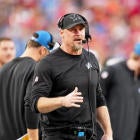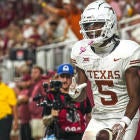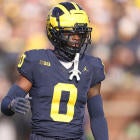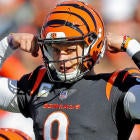After more than a decade on ice, a controversial 2006 interview with O.J. Simpson finally aired Sunday and left a lot of viewers believing that Simpson might have actually confessed to the June 1994 murders of his ex-wife Nicole Brown Simpson and Ronald Goldman.
In the interview, which Fox billed as "O.J. Simpson: The Lost Confession," Simpson talks about the murders for the first time on camera. In the interview, O.J. "hypothetically" describes how he would have committed the murders if he had been the one who pulled them off.
The woman who conducted the original interview in 2006, Judith Regan, explained during Sunday's show that the interview was pitched to her as O.J.'s confession, but he wanted to use the word "hypothetical" so that he had plausible deniability with his kids.
"I received a phone call from an attorney who said 'O.J. is ready to confess,'" Regan said in Sunday's show, when asked how the interview came together. "The only condition that he had was that he didn't want to call the book I Did It. He wanted to put an 'if' in front of it so that he would have deniability with his children. He couldn't face his children and he couldn't tell them that he had done it. That was the way it was portrayed to me."
Simpson did the interview as he was getting set to release a book in 2006 called If I Did It. Regan was shocked that he was releasing the book, because if he did it, then he's confessing to a crime and if he didn't do it, then he's writing a book about hypothetically killing his ex-wife.
"From my point of view, who would even do this, even as a hypothetical, unless they had committed the murders," Regan said during Sunday's show.
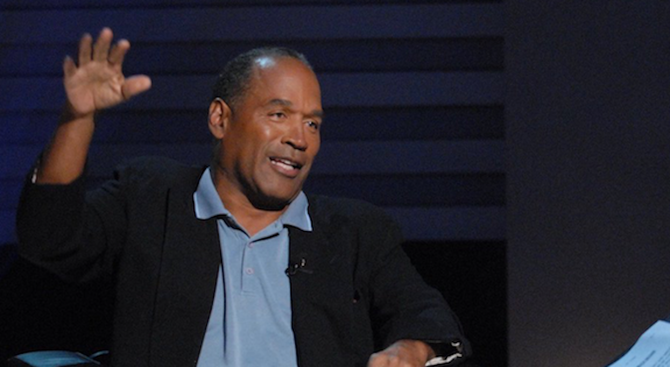
So what did Simpson have to say during his 12-year-old interview?
For one, he started out by clearly stating that the entire scenario being presented was hypothetical.
"This is very difficult for me to do this," Simpson said of recounting the night of June 12, 1994. "It was very difficult for me because it's hypothetical. I know and I accept the fact that people are going to feel whatever way they're going to."
Simpson then hypothetically describes the beginning of the night when he met up with a friend named "Charlie."
"In the book, the hypothetical is, this guy Charlie shows up, this guy I used to be friends with and I don't know why he had been by Nicole's house, but he told me, 'You won't believe what's going on over there.' And I remember thinking, 'Whatever's going on over there, that has got to stop,'" Simpson said.
At that point, Regan asks Simpson where he parked at Nicole's and what he was wearing when he went over there.
"In the hypothetical, in the alley [is where I parked]," Simpson said. "In the hypothetical, I put on the cap and gloves."
Simpson also noted that he usually kept a knife in his car.
"I always kept a knife in the car for the crazies and stuff because you can't travel with a gun and I remember Charlie saying, 'You ain't bringing that [to Nicole's]' and I didn't, but I believe he took it," Simpson said. "In the book."
After describing that scene, things got kind of weird, because Simpson went from describing everything hypothetically to describing everything in the first person.
"I go to the front and I'm looking to see what's going on," Simpson said. "While I was there, a guy [Goldman] shows up. A guy I really didn't recognize. I may have seen him around, but I really didn't recognize him to be anyone. In the mood I was in, I started having words with him."
Nicole heard the argument and went outside. At that point, a verbal argument started, according to Simpson's account.
"Nicole had come out and we started having words about 'Who is this guy? Why is he here? What's going on?'" Simpson said. "As things got heated, I just remember that Nicole fell and hurt herself and this guy kind of got into a karate thing, and I said, 'Well, you think you can kick my ass?' And then I remember I grabbed the knife, I do remember that portion, taking the knife from Charlie."
From there, Simpson told Regan that he blacked out.
"To be honest, after that I don't remember, except, I'm standing there and there's all kinds of stuff around ... blood and stuff around," Simpson said.
You can see that portion of the interview below.
"Taking the knife from Charlie, and to be honest, after that I don't remember. Except I'm standing there and there's all kind of stuff around ... blood and stuff around..." *breaks into laughter* - O.J. Simpson #DidOJConfesspic.twitter.com/eZA27EERli
— Jordan Heck (@JordanHeckFF) March 12, 2018
When asked if he was covered in blood, Simpson said "everything was covered."
"It's hard for me to describe it. I don't think any two people could be murdered the way they were without everyone being covered in blood," Simpson said. "Of course, I think we've all seen the grisly pictures after. I think everything was covered, would have been covered in blood."
Regan then mentions that, in the book, Simpson says he removed a glove at that point.
"I have no conscious memory of doing that, but obviously I must have because they found the glove there," Simpson said.
Regan then asked Simpson if he had ever blacked out before.
"Not to my knowledge," Simpson said. "Of course, if something like this were to take place in anybody's life, if it were to happen, I would imagine it would be something you would probably have trouble wrapping your mind around. It was horrible. It was absolutely horrible."
Simpson then described leaving the scene.
"I go back, parked a block away because I knew the limo would be there. Came across the backyard through the two tennis courts and came through the house," Simpson said.
The former NFL star was about to catch a flight to Chicago, which why there was limo at his place that night. Once in his house, Simpson says he "ran upstairs to take a shower."
After Simpson described the hypothetical details of the crime, viewers at home were shocked.
Dude, OJ is definitely guilty... he literally just laid out the entire night #DidOJConfess #HELLyes
— Alex Harris (@alexandraa6895) March 12, 2018
Oj is guilty, that was 100% a confession hypothetical or not. Don’t @ me. #DidOJConfess
— Jess 💋 (@JessicaAnn261) March 12, 2018
this man is crazy as he'll. crazy enough to murder 2 people and laugh about it #OJSimpson #DidOJConfess
— New Youtuber👑 (@RelliiG) March 12, 2018
It’s crazy how this guy got away with a double murder, he’s confessing on national television and he’s so arrogantly flaunting it #DidOJConfess
— Bobby Thompson (@BThomps81) March 12, 2018
After describing the night of June 12 in first person, Simpson went back to defending himself when it came to key details after the murder. The Pro Football Hall of Famer even explained why he had a passport during the Bronco chase and also said that he didn't have $10,000 with him in the car, as police have long claimed.
"There wasn't a lot of conversation [in the Bronco]," Simpson said. "I always had my passport [on me]. I think I had three dollars and something in change [not $10,000]."
Although Simpson was acquitted of the murders in October 1995, he was later found liable for the deaths in civil court. The former Buffalo Bills running back was ordered to pay $33.5 million after a judge ruled against him in wrongful death lawsuits filed by the families of the victims.
The interview with Simpson in 2006 never aired because Fox decided to pull it after facing serious backlash from the general public. In November 2006, Fox was going to air the interview in a two-part special before Rupert Murdoch personally announced that it was going to be axed.
Not only did Fox shelve the TV special, but it also dumped the book. Most of the first-print copies were destroyed in 2006, and the ones that didn't get destroyed became collector's items. An original printing of the book sold for $4,555 at an auction in October 2017.
Although the book was axed by publisher Harper Collins, which was owned by Fox, another version of it eventually did get released. After a judge gave the rights of the book to the Goldmans, the family released the book in August 2007 as a way to collect on the $33.5 million court ruling against Simpson. The family believed that the book was Simpson's way of confessing to the crime, so when they released it, they retitled the book, If I Did It: Confessions of the Killer.
Fourteen months after the book was released, Simpson was sent to jail after being found guilty of kidnapping and robbery in Nevada. Simpson spent roughly nine years in prison before being released on Oct. 1, 2017. Simpson hasn't yet commented on the Sunday airing of his 12-year-old interview. However, the Goldman family was on board with the interview airing, because, as mentioned before, they viewed it as Simpson's way of confessing to the murder.















